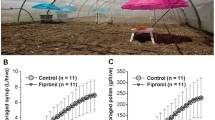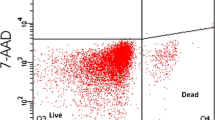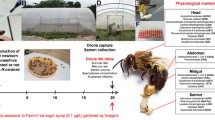Abstract
The effect of agrochemicals and beekeeping treatments on drones have not been widely investigated compared to workers or queens. In the present study, we investigated the chronic exposure of chemicals set (deltamethrin, acetamiprid, oxalic acid, fumagillin, and amitraz) on some sperm parameters and on the histomorphology of seminal vesicles. We also assessed the colony development and nosema load before and after the exposure. Thirty native Apis mellifera anatolica honeybee colonies with sister queens equalized with brood and total frame of bees were used for this experiment. Five colonies were used for each group. Deltamethrin, acetamiprid and fumagillin were given as oral chronic exposure at final concentrations of 25.10-6 mg L−1, 0.01 m L−1 and 50 mg L−1 respectively in syrup solution (50/50). Colonies were exposed to oxalic acid by spraying 5 mL per frame space of 3% (w/v) of oxalic acid dihydrate. Finally, the amitraz was applied based on the manufacturer’s instructions. The concentrations chosen represented the field-realistic concentrations and those used by beekeepers in the region. Results showed that deltamethrin reduced brood production. In the same group, we found a high increase in nosema load. All treatments decreased sperm count except for fumagillin but this compound increased sperm mortality and increased the percentage of sperm with defected acrosome integrity. The amitraz exhibited a high sperm mortality and high percentage of sperm with defected membrane integrity function. The sperm parameters such as the count, the motility, the acrosome integrity, the membrane function of sperm, and the histomorphology of seminal vesicles of drones exposed to oxalic acid were the most affected. Bee medications commonly used such as oxalic acid and fumagillin should be more investigated and should be considered by beekeepers and particularly queen breeders.





Similar content being viewed by others
References
Acharyya S, Chatterjee MM (2018) Assessment of reproductive toxicity in Monocrotophos (organophosphate pesticide)-exposed Nile tilapia (Oreochromis niloticus) sperm using Biochemical assays and CASA-based sperm kinematics. Int J Eng Sci 7:105–111
Alaux C, Brunet J-L, Dussaubat C, Mondet F, Tchamitchan S, Cousin M, Brillard J, Baldy A, Belzunces LP, Le Conte Y (2010) Interactions between Nosema microspores and a neonicotinoid weaken honeybees (Apis mellifera). Environ Microbiol 12:774–782. https://doi.org/10.1111/j.1462-2920.2009.02123.x
Almadaly E, El-Kon I, Heleil B, Fattouh el S, Mukoujima K, Ueda T, Hoshino Y, Takasu M, Murase T (2012) Methodological factors affecting the results of staining frozen-thawed fertile and subfertile Japanese Black bull spermatozoa for acrosomal status. Anim Reprod Sci 136:23–32. https://doi.org/10.1016/j.anireprosci.2012.10.016
Aufauvre J, Biron DG, Vidau C, Fontbonne R, Roudel M, Diogon M, Viguès B, Belzunces LP, Delbac F, Blot N (2012) Parasite-insecticide interactions: a case study of Nosema ceranae and fipronil synergy on honeybee. Sci Rep 2:326–326. https://doi.org/10.1038/srep00326
Baines D, Wilton E, Pawluk A, de Gorter M, Chomistek N (2017) Neonicotinoids act like endocrine disrupting chemicals in newly-emerged bees and winter bees. Sci Rep 7:10979–10979. https://doi.org/10.1038/s41598-017-10489-6
Banerjee BD, Seth V, Ahmed RS (2001) Pesticide-induced oxidative stress: perspective and trends. Environ Health Rev 16:1–40
Ben Abdelkader F (2019) Impact of pesticides on Honeybee (Apis mellifera L.) drones. U Bee J 19:188–194. https://doi.org/10.31467/uluaricilik.626929
Ben Abdelkader F, Kairo G, Tchamitchian S, Bonnet M, Cousin M, Barbouche N, Belzunces L, Brunet J (2018) Effects of clothianidin exposure on semen parameters of honey bee drones. J New Sci 59:3791–3798
Ben Abdelkader F, Kairo G, Tchamitchian S, Cousin M, Senechal J, Crauser D, Vermandere JP, Alaux C, Le Conte Y, Belzunces LP, Barbouche N, Brunet J-L (2014) Semen quality of honey bee drones maintained from emergence to sexual maturity under laboratory, semi-field and field conditions. Apidologie 45:215–223. https://doi.org/10.1007/s13592-013-0240-7
Ben Abderkader F, Kairo G, Tchamitchian S, Bonnet M, Cousin M, Barbouche N, Belzunces L, Brunet J (2018) Effects of clothianidin exposure on semen parameters of honey bee drones. J New Sci 59:3791–3798
Büchler R (1999) Versuchsergebnisse zur varroatosebekämpfung durch aufträufeln von oxalsäurelösung auf die wintertraube. Environ Health Rev 33:5–8
Burley LM (2007) The effects of miticides on the reproductive physiology of honey bee (Apis mellifera L.) queens and drones. Unpublished MSc Thesis in life sciences
Çakmak İ, Hranitz JM, Blatzheim L, Bower CD, Polk T, Levinson B, Wells H (2018) Effects of thiamethoxam on the behavior of foraging honey bees with artificial flower choices. U Bee J 18:31–38. https://doi.org/10.31467/uluaricilik.427583
Çakmak I, Seven Çakmak S (2016) Beekeeping and recent colony losses in Turkey. U.Bee J 16(1):31–48. https://doi.org/10.31467/uluaricilik.379276
Chauzat MP, Carpentier P, Martel AC, Bougeard S, Cougoule N, Porta P, Lachaize J, Madec F, Aubert M, Faucon JP (2009) Influence of pesticide residues on honey bee (Hymenoptera: Apidae) colony health in France. Environ Entomol 38:514–523. https://doi.org/10.1603/022.038.0302
Cobey S (1983) Drone rearing for instrumental insemination III. Amer Bee J 123:284–289
Cobey S (2007) Comparison studies of instrumentally inseminated and naturally mated honey bee queens and factors affecting their performance. Apidologie 38:390–410
Crossmon G (1937) A modification of Mallory’s connective tissue stain with a discussion of the principles involved. Anatomical Record 69:33–38. https://doi.org/10.1002/ar.1090690105
Dai P-L, Wang Q, Sun J-H, Liu F, Wang X, Wu Y-Y, Zhou T (2010a) Effects of sublethal concentrations of bifenthrin and deltamethrin on fecundity, growth, and development of the honeybee Apis mellifera ligustica. Environ Toxicol Chem 29:644–649. https://doi.org/10.1002/etc.67
Decourtye A, Devillers J, Cluzeau S, Charreton M, Pham-Delègue M (2004) Effects of imidacloprid and deltamethrin on associative learning in honeybees under semi-field and laboratory conditions Ecotoxicol Environ Saf 57(3):410–419
El-Nahhal Y (2020) Pesticide residues in honey and their potential reproductive toxicity. Science of The Total Environment 741:139953. https://doi.org/10.1016/j.scitotenv.2020.139953
Fanaei H, Khayat S, Halvaei I, Ramezani V, Azizi Y, Kasaeian A, Mardaneh J, Parvizi MR, Akrami M (2014) Effects of ascorbic acid on sperm motility, viability, acrosome reaction and DNA integrity in teratozoospermic samples. Iran J Reprod Med 12:103–110
Fisher A (2017) Assessing the potential threat of widely used agrochemicals to honey bee (Apis mellifera L.) Drones and Workers. Texas A & M University
Flint HM, Eaton J, Klassen W (1972) The use of fumidil-B1 to reduce microsporidian disease in colonies of the boll weevil2. Ann Entomol Soc Am 65:942–945. https://doi.org/10.1093/aesa/65.4.942
Fukuda H, Ohtani T (1977) Survival and life span of drone honeybees. Res Pop Ecol 19:51–68. https://doi.org/10.1007/bf02510939
Gąbka J (2014) Correlations between the strength, amount of brood and honey production of the honey bee colony. Medycyna Weterynaryjna 70:754–756
Higes M, Meana A, Suárez M, Llorente J (1999) Negative long-term effects on bee colonies treated with oxalic acid against Varroa jacobsoni Oud. Apidologie 30:289–292
Johnson RM, Dahlgren L, Siegfried BD, Ellis MD (2013) Effect of in-hive miticides on drone honey bee survival and sperm viability. J Api Res 52:88–95
Kadirvel G, Kumar S, Kumaresan A (2009) Lipid peroxidation, mitochondrial membrane potential and DNA integrity of spermatozoa in relation to intracellular reactive oxygen species in liquid and frozen-thawed buffalo semen. Anim Reprod Sci 114:125–134
Kairo G, Biron DG, Ben Abdelkader F, Bonnet M, Tchamitchian S, Cousin M, Dussaubat C, Benoit B, Kretzschmar A, Belzunces LP, Brunet J-L (2017a) Nosema ceranae, Fipronil and their combination compromise honey bee reproduction via changes in male physiology. Sci. Rep 7:8556. https://doi.org/10.1038/s41598-017-08380-5
Kairo G, Poquet Y, Haji H, Tchamitchian S, Cousin M, Bonnet M, Pelissier M, Kretzschmar A, Belzunces LP, Brunet J-L (2017b) Assessment of the toxic effect of pesticides on honey bee drone fertility using laboratory and semifield approaches: a case study of fipronil. Environ Toxicol Chem 36:2345–2351. https://doi.org/10.1002/etc.3773
Kairo G, Provost B, Tchamitchian S, Ben Abdelkader F, Bonnet M, Cousin M, Sénéchal J, Benet P, Kretzschmar A, Belzunces LP, Brunet J-L (2016a) Drone exposure to the systemic insecticide Fipronil indirectly impairs queen reproductive potential. Sci Rep 6:31904. https://doi.org/10.1038/srep31904
Karahan A, Çakmak I, Hranitz JM, Karaca I, Wells H (2015) Sublethal imidacloprid effects on honey bee flower choices when foraging. Ecotoxicology 24:2017–2025. https://doi.org/10.1007/s10646-015-1537-2
Kraus FB, Neumann P, Scharpenberg H, Van Praagh J, Moritz RFA (2003) Male fitness of honeybee colonies (Apis mellifera L.). J Evol Biol 16:914–920. https://doi.org/10.1046/j.1420-9101.2003.00593.x
Lewis LC, Lynch RE (1970) Treatment of Ostrinia nubilalis larvae with Fumidil B to control infections caused by Perezia pyraustae. J Invertebr Pathol 15:43–48. https://doi.org/10.1016/0022-2011(70)90096-0
Metz BN, Tarpy DR (2019) Reproductive senescence in drones of the honey bee (Apis mellifera). Insects 10:11. https://doi.org/10.3390/insects10010011
Michener CD (1979) Biogeography of the bees. Ann Missouri Bot Gard 66:277–347. https://doi.org/10.2307/2398833
Mullin CA, Frazier M, Frazier JL, Ashcraft S, Simonds R, vanEngelsdorp D, Pettis JS (2010) High levels of miticides and agrochemicals in North American apiaries: implications for honey bee health. PLoS ONE 5:e9754. https://doi.org/10.1371/journal.pone.0009754
Nur Z, Dogan I, Gunay U, Soylu MK (2005) Relationships between sperm membrane integrity and other semen quality characteristics of the semen of Saanen goat bucks. Bull Vet Inst Pulawy 49:183–187
Nur Z, Seven-Cakmak S, Ustuner B, Cakmak I, Erturk M, Abramson CI, Sağirkaya H, Soylu MK (2012) The use of the hypo-osmotic swelling test, water test, and supravital staining in the evaluation of drone sperm. Apidologie 43:31–38. https://doi.org/10.1007/s13592-011-0073-1
Nur Z, Zik B, Ustuner B, Sagirkaya H, Ozguden CG (2010) Effects of different cryoprotective agents on ram sperm morphology and DNA integrity. Theriogenology 73:1267–1275. https://doi.org/10.1016/j.theriogenology.2009.12.007
Peng CYS, Yin CM, Yin LRS (1992) Effect of rapid freezing and thawing on cellular integrity of honey bee sperm. Physiol Entomol 17:269–276. https://doi.org/10.1111/j.1365-3032.1992.tb01021.x
Perveen FK (2012) Insecticides: pest engineering. IntechOpen, Croatia
Pettis JS, Rice N, Joselow K, vanEngelsdorp D, Chaimanee V (2016) Colony failure linked to low sperm viability in honey bee (Apis mellifera) queens and an exploration of potential causative factors. PLoS ONE 11:e0147220–e0147220. https://doi.org/10.1371/journal.pone.0147220
Pettis JS, vanEngelsdorp D, Johnson J, Dively G (2012) Pesticide exposure in honey bees results in increased levels of the gut pathogen Nosema. Die Naturwissensch 99:153–158. https://doi.org/10.1007/s00114-011-0881-1
Pina-Guzman B, Sánchez-Gutiérrez M, Marchetti F, Hernández-Ochoa I, Solis-Heredia M, Quintanilla-Vega B (2009) Methyl-parathion decreases sperm function and fertilization capacity after targeting spermatocytes and maturing spermatozoa. Toxicol Appl Pharmacol 238:141–149
Pohorecka K, Skubida P, Semkiw P (2018) Varroacidal efficiency of treatment with amitraz in honey bee colonies with brood. J Apic Sci 62:285. https://doi.org/10.2478/jas-2018-0026
Prasanthi K, Rajini P (2005) Morphological and biochemical perturbations in rat erythrocytes following in vitro exposure to Fenvalerate and its metabolite. Toxicol In Vitro 19:449–456
Ramu S, Jeyendran RS (2013) The hypo-osmotic swelling test for evaluation of sperm membrane integrity. In: Carrell DT, Aston KI (eds) Spermatogenesis: methods and protocols. Humana Press, Totowa, NJ, pp 21–25. https://doi.org/10.1007/978-1-62703-038-0_3
Rangel J, Fisher A (2019) Factors affecting the reproductive health of honey bee (Apis mellifera) drones—a review. Apidologie 50:759–778. https://doi.org/10.1007/s13592-019-00684-x
Rhodes JW, Harden S, Spooner-Hart R, Anderson DL, Wheen G (2010) Effects of age, season and genetics on semen and sperm production in Apis mellifera drones. Apidologie 42:29–38
Sabova L, Sobekova A, Staron M, Sabo R, Legath J, Staronova D, Lohajova L, Javorsky P (2019) Toxicity of oxalic acid and impact on some antioxidant enzymes on in vitro-reared honeybee larvae. Environ Sci Poll Res Int 26:19763–19769. https://doi.org/10.1007/s11356-019-05247-2
Sanchez-Bayo F, Goka K (2014) Pesticide residues and bees-a risk assessment. PLoS ONE 9:e94482–e94482. https://doi.org/10.1371/journal.pone.0094482
Sanchez-Bayo F, Goka K (2016) Impacts of pesticides on honey bees. Beekeep Bee Conserv 4:77–97
Sandrock C, Tanadini M, Tanadini LG, Fauser-Misslin A, Potts SG, Neumann P (2014) Impact of chronic neonicotinoid exposure on honeybee colony performance and queen supersedure. PLoS ONE 9:e103592. https://doi.org/10.1371/journal.pone.0103592
Sawarkar A, Tembhare D (2015) Histomorphological study of the male reproductive system in the Indian drone Honeybee, Apis cerana indica (Hymenoptera). In: National conference on advances in bioscience & environmental science: present & future (ABES), p 63
Shi J, Yang H, Yu L, Liao C, Liu Y, Jin M, Yan W, Wu XB (2020) Sublethal acetamiprid doses negatively affect the lifespans and foraging behaviors of honey bee (Apis mellifera L.) workers. Sci Total Environ 738:139924. https://doi.org/10.1016/j.scitotenv.2020.139924
Shoukry R, Khattaby A, El-Sheakh A, Abo-Ghalia A, Elbanna S (2013) Effect of some materials for controlling varroa mite on the honeybee drones (Apis mellifera L.). Egypt J Agric Res 91:825–834
Straub L, Villamar-Bouza L, Bruckner S, Chantawannakul P, Gauthier L, Khongphinitbunjong K, Retschnig G, Troxler A, Vidondo B, Neumann P, Williams GR (2016) Neonicotinoid insecticides can serve as inadvertent insect contraceptives. Proc Biol Sci. 283 https://doi.org/10.1098/rspb.2016.0506
Taylor MA, Guzman-Novoa E, Morfin N, Buhr MM (2009) Improving viability of cryopreserved honey bee (Apis mellifera L.) sperm with selected diluents, cryoprotectants, and semen dilution ratios. Theriogenology 72:149–159. https://doi.org/10.1016/j.theriogenology.2009.02.012
Wakonigg G, Eveleigh L, Arnold G, Crailsheim K (2000) Cuticular hydrocarbon profiles reveal age-related changes in honey bee drones (Apis mellifera carnica). J Api Res 39:137–141
Whittington R, Winston ML (2003) Effects of Nosema bombi and its treatment fumagillin on bumble bee (Bombus occidentalis) colonies. J Invertebr Pathol 84:54–58. https://doi.org/10.1016/s0022-2011(03)00123-x
Winston ML (1987) The biology of the honey bee. Harvard University Press.
Wu-Smart J, Spivak M (2016) Sub-lethal effects of dietary neonicotinoid insecticide exposure on honey bee queen fecundity and colony development. Sci Rep 6:32108–32108. https://doi.org/10.1038/srep32108
Wu JY, Smart MD, Anelli CM, Sheppard WS (2012) Honey bees (Apis mellifera) reared in brood combs containing high levels of pesticide residues exhibit increased susceptibility to Nosema (Microsporidia) infection. J Invertebr Patho. 109:326–329. https://doi.org/10.1016/j.jip.2012.01.005
Acknowledgements
This study was supported in part by Türkiye Scholarship Bursları Program and by Beekeeping Development-Application and Research Center (AGAM) Bursa Uludag University. We also would like to thank the beekeeping technician Eşref Tiraki for helping field experiments and anonymous reviewers who provided valuable comments to the final version of the manuscript.
Author contributions
F.B.A. and I.Ç. planned and designed the study. Together with S.Ç. carried out the field experiments. F.B.A., S.Ç., Z.N. and A.A. performed laboratory sperm analysis E.Ì. and H.E. performed the histology analysis. The manuscript was written by F.B.A. and all authors commented on previous versions of the manuscript. All authors read and approved the final manuscript.
Author information
Authors and Affiliations
Corresponding author
Ethics declarations
Conflict of interest
The authors declare no competing interests.
Consent to publish
Informed consent was obtained from all individual participants included in the study.
Additional information
Publisher’s note Springer Nature remains neutral with regard to jurisdictional claims in published maps and institutional affiliations.
Rights and permissions
About this article
Cite this article
Ben Abdelkader, F., Çakmak, İ., Çakmak, S.S. et al. Toxicity assessment of chronic exposure to common insecticides and bee medications on colony development and drones sperm parameters. Ecotoxicology 30, 806–817 (2021). https://doi.org/10.1007/s10646-021-02416-3
Accepted:
Published:
Issue Date:
DOI: https://doi.org/10.1007/s10646-021-02416-3




